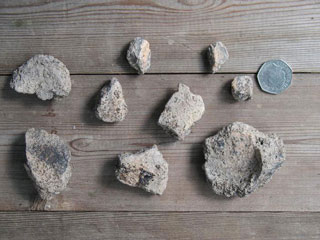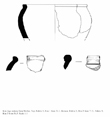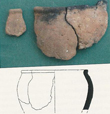
Prehistoric Pottery
 The site has yielded very many sherds of Prehistoric Pottery which can be notoriously difficult to identify and ranges from Bronze Age to late Iron Age in date.
The site has yielded very many sherds of Prehistoric Pottery which can be notoriously difficult to identify and ranges from Bronze Age to late Iron Age in date. Initially it was difficult to work out the relationship between Mellor and other sites in the area as little material culture had been found elsewhere, making attempts to establish a sequence of pottery types almost impossible.
Between 1998 and 2002 however, several hundred sherds of later prehistoric pottery were found, mostly from the excavations of the ditch. The most notable of these were the 140 pieces of the sameitem, which were able to be reconstructed and came to be known as the Mellor Pot.
Thin Section analysis was carried out on pottery sherds identified as Iron Age and found within the ditch, petrological analysis of the clays used in the production of the pottery and helping to determine their origins. Slices were also examined under the microscope allowing the fabric to be compared to known sources.
What types of Pottery have we found
Analysis of the assemblage at Mellor divided the pottery into six main types of fabric, from fine, soft, sandy textured fabric to hard, dense, robust types. The fabric of the Mellor Pot forms one of these types, being a moderately hard, muddy textured fabric containing quantities of angular, non-crystalline rock fragments, traces of grass stems in the fired body and a smoothed surface. The rarity of large sherds makes it difficult to be certain about the shape of the majority of the pots but Four Rim forms have been defined:
- A low, flat topped, beaded rim on a globular body, small everted lip distinguishing the form from the commoner straight rounded rims.
- A simple, unelaborated, rounded rim with a slightly flattened top.
- A round, beaded rim with a pronounced external bulge.
- A simple rounded rim, probably generally similar to that of the Mellor Pot.
The Mellor pottery is entirely hand made, probably using the slab building rather than coiling technique. None of the vessels recovered to date was decorated and finishing was limited to smoothing and pinching, the latter notably on the rim of the Mellor Pot. Other vessels have simple flat topped, everted rims finished by hand, probably with the aid of a piece of polished wood or bone.
It would seem that although pottery is rare and it's use was restricted, it was being manufactured in small amounts in the region in the Later Iron Age and also imported, in similarly small amounts, from areas further south and east such as Lincolnshire and the East Midlands.
What was it used for
The functions of the vessels are unknown. Given the small size of the assemblage and the scarcity of pottery in the region generally, it seems unlikely that everyday cooking and eating depended on the use of pottery, suggesting either that cooking techniques were based on roasting or baking or that organic containers were used, perhaps in conjuction with hot stones, although some signs of burning ( in the form of blackening and apparently burnt deposits) were visible on some of the sherds. Investigation of organic residues surviving within the body of the vessels may be able to cast light on the uses to which the vessels were put.
Read the full 2003 Prehistoric Pottery Report



The Pottery from Shaw Cairn
Dr Alison Sheridan of the National Museums of Scotland was asked to examine the Bronze Age Amber Beads from the excavations at Shaw Cairn and also kindly examined the sherds of prehistoric pottery which from the site. She was able to separate them into parts of 10 different vessels:
Dr Alison Sheridan of the National Museums of Scotland was asked to examine the Bronze Age Amber Beads from the excavations at Shaw Cairn and also kindly examined the sherds of prehistoric pottery which from the site. She was able to separate them into parts of 10 different vessels:
-
6 definite Food Vessels
3 possible/probable urns (smallish, and in the Food Vessel tradition - certainly so in one case)
3 rimsherds and some body sherds of one thin, tiny, plain accessory vessel, which appears to have been burnt,
suggesting that small pots such as these were used to bring the glowing embers that were used to light the pyre.
The cremation deposit Hector seems to have had parts of 5 pots present (2 Food Vessels, 2 possible ursn plus the accessory vessel) which suggests that there may have been more than one interment in that grave. There are several good examples of where pots have come apart along ring joint lines, and these show how the pots had been built up. It may be possib;le ton carry out lipid analysis to see whether any of the funerary pottery had been used for cooking before burial.
How old is the Shaw Cairn Pottery
Nothing demonstrably later than the Early Bronze Age and no Beaker pottery was found. Food Vessels are frequently associated with cremated remains for this part of Britain. The fact that there are so many Food Vessels supports the view that the cairn may only have been used for a few generations, possibly between around 4,100 and 3,800 years ago. It may be possible to obtain Carbon 14 dates from the cremated remains and Osteology Reports from the fragments of bone to see whether, as is sometimes the case, deposits contain more than one individual.
Nothing demonstrably later than the Early Bronze Age and no Beaker pottery was found. Food Vessels are frequently associated with cremated remains for this part of Britain. The fact that there are so many Food Vessels supports the view that the cairn may only have been used for a few generations, possibly between around 4,100 and 3,800 years ago. It may be possible to obtain Carbon 14 dates from the cremated remains and Osteology Reports from the fragments of bone to see whether, as is sometimes the case, deposits contain more than one individual.
With thanks to Dr Chris Cumberpatch and Dr Alison Sheridan





